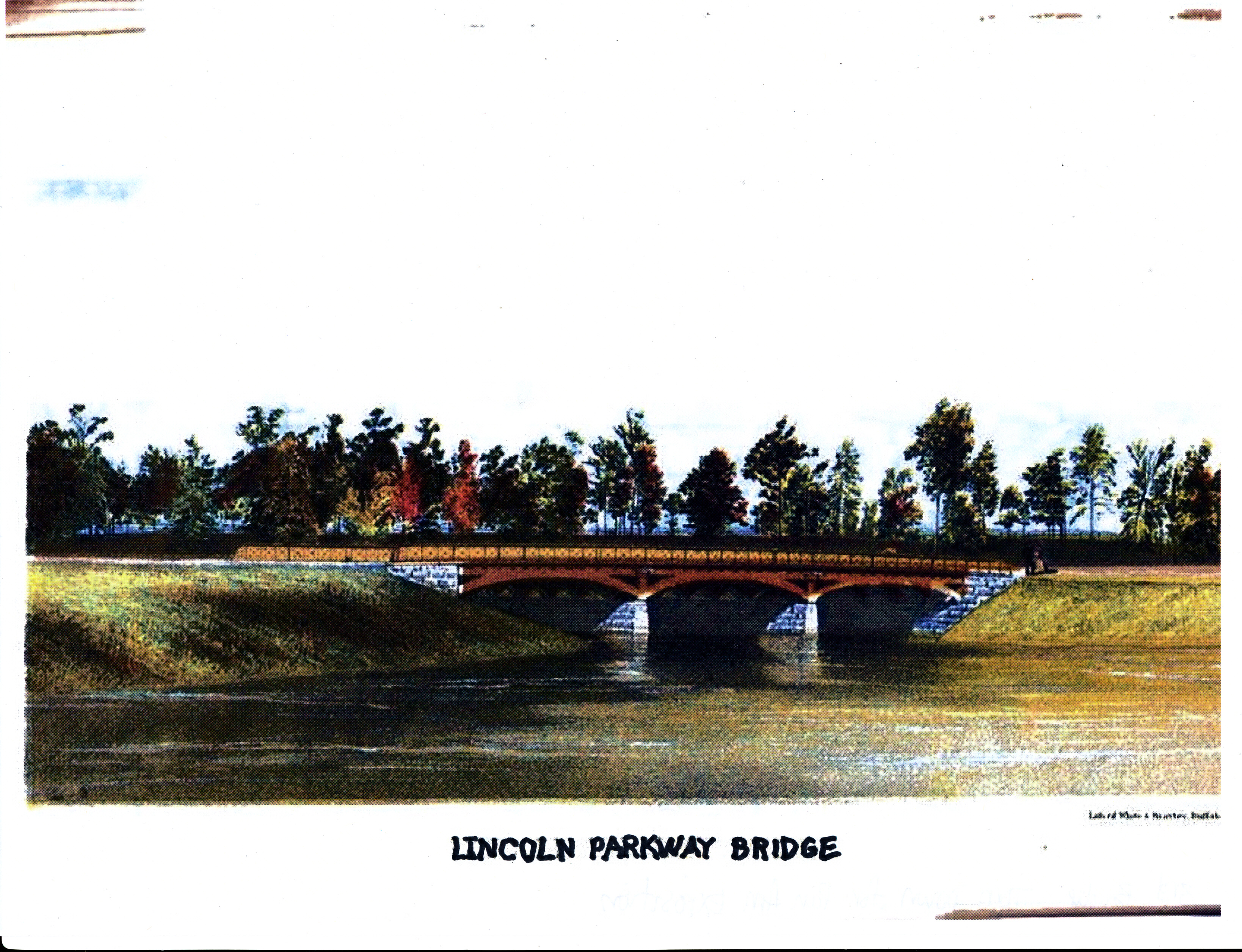WHEN YOU DRIVE OVER THE LINCOLN PARKWAY BRIDGE PAST HOYT LAKE ONTO THE SCAJAQUADA ROADWAY, YOU MAY NOTICE THOSE GRANITE FINIALS FOR A COUPLE OF SECONDS AS YOU PASS.
They are successors to the oak and cast iron railings of the past. This bridge is the third to span that spot over our park lake.
The first bridge was designed by Calvert Vaux, partner and mentor to Frederick Law Olmsted. It was completed in the spring of 1872 just as “the Park” (later named Delaware Park) was being sculpted into final form. It was 55 feet wide with a 35-foot carriage way and two 10-foot pedestrian promenades, each section surfaced with wooden planks.
The abutments of the bridge and its three arches were made of limestone blocks cut from a quarry located in the park near the present Parkside Lodge. Massive oak girders supported the bridge roadway. Classic Victorian colors of umber, yellow and green added detail to its arches, elaborate side panels and railings. On both sides, the middle of each arch had its own overhanging balcony with built-in benches so that pedestrians could pause and admire the pastoral view of the lake.
Constant maintenance was needed on the wood components of the bridge. Upkeep became such a problem that by 1890 a new cast iron bridge was built at a cost of $14,000. The wood plank roadway was replaced by the latest paving material, Trinidad asphalt, imported from the Caribbean island lake that has the largest natural asphalt deposit in the world. The projecting balconies were replicated in the new design.
One incident in the construction of this second bridge happened to William McMillan, longtime park supervisor. On a carriage ride to inspect the new construction, he spotted several thieves stealing construction material. He confronted the men, who attacked him, broke his nose with a metal pipe and then fled. They were never caught and McMillan sported a crooked nose for the rest of his life.
As planning for the Pan American Exposition of 1901 proceeded, the organizers felt that the cast iron bridge was too old-fashioned and needed to be updated as part of the grand entrance to the fair. Buffalo architects Green and Wicks designed the new stone bridge in the “Venetian style” of architecture to compliment the planned Venetian lagoon (Hoyt Lake), the canals and the imported gondolas and gondoliers.
The Venetian theme was further emphasized by the stone carvings over the three bridge arches. One side featured the three greatest Grand Dukes or Doges of Venice: Dandolo, Michaeli and Morosini. The other side has two generic Native American profiles and a center female figure to represent Buffalo. Four lions anchoring the ends of the bridge were reminiscent of the lions in Piazza San Marco in Venice but lacking their wings. Made of plaster, these lions were never meant to last longer than a couple of years. After the exposition, it was proposed to replace them with bronze replicas paid for by donors who would be recognized with a plaque on the base. The idea never took hold and the lions disappeared. The Buffalo Olmsted Parks Conservancy is exploring the possibility of replicating these iconic bridge guardians in concrete.
This bridge was known as “The Bridge of the Three Americas” to reflect the Pan American theme of the exposition with its focus on North, Central and South America.
Venice has more than 400 bridges, and the Venetians look at them differently than we do. They see them as connectors from one scene to another, or even from one reality to another, to be enjoyed as such. With time and careful planning, this bridge may once again become the Venetian ideal to cross.
The Conservancy is responsible for the Olmsted parks. While the city provides 40% of the budget, the rest is up to us folks. If you love our beautiful, well-maintained parks and their rich history, please join here. Membership is inexpensive and disproportionately satisfying.
Next time we’ll explore: Where did the cannons go?
Written by: Jim Mendola, volunteer archivist and historian
Source: https://www.buffalorising.com/2017/06/the-bridges-of-lincoln-parkway/






